History
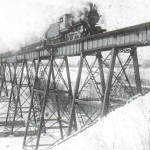 Trains have always fascinated me. I love to ride them, and I love to watch them. I suppose that it could be something that is in my blood, since some of my family members, including my grandpa and my Uncle Bill both worked for the railroad. Or maybe it is just my personal opinion, but I think trains are cool. Whenever Bob and I go somewhere that offers a train ride, we try to plan that into our trip. If you have never taken a ride on a train, you really should consider it sometime. You won’t be disappointed. It is like a time machine, of sorts, taking you back into history.
Trains have always fascinated me. I love to ride them, and I love to watch them. I suppose that it could be something that is in my blood, since some of my family members, including my grandpa and my Uncle Bill both worked for the railroad. Or maybe it is just my personal opinion, but I think trains are cool. Whenever Bob and I go somewhere that offers a train ride, we try to plan that into our trip. If you have never taken a ride on a train, you really should consider it sometime. You won’t be disappointed. It is like a time machine, of sorts, taking you back into history.
The history of trains and the railroad itself is a fascinating one. In a very primitive form, trains existed back as far as 600BC, to move goods from ships to where they needed to go. Early miners had a primitive train since about 1500, called a Wagonway. It really was an invention of necessity. It was very difficult to haul ore out of a mine with a horse and wagon…or a wheelbarrow for that matter. By coming up with a way to transport the ore in wagons on a rail system, it got much easier. Of course, this system wasn’t much good if you were going to go very far, because let’s face it, a series of 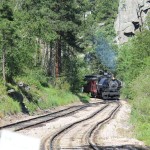 wagons going very far is a slow mode of travel, and it wouldn’t be a Wagonway anyway, because that is called a Wagon Train…oddly enough.
wagons going very far is a slow mode of travel, and it wouldn’t be a Wagonway anyway, because that is called a Wagon Train…oddly enough.
The implementation of the rail system in the United States was necessary to our future too. Getting from one side of this country to the other is not an easy task. Even with the benefit of cars these days, driving cross country takes several days. And while the early trains weren’t much faster than our cars are, you could sleep at night, and keep going. At first the trains only carried supplies and such, but it wasn’t to be very long before they carried people. The first fare paying passenger train began operating in 1807 in Swansea, Wales. From that time on, more and more trains would carry passengers, and in many ways the world became a smaller place after that. Soon trains would criss-cross the United States, and train travel became common. It wasn’t common to just everyplace right away, however, but on this day, January 22, 1888, the first passenger train came into Cheyenne, Wyoming. It left the same day, making Wyoming history…two years before we even became a state.
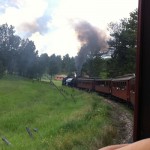 Travel by train would begin to make people feel like they had really come into the modern ages for a while, but with cars and airplanes, it wouldn’t take long for train travel to almost become obsolete. These days, I think that like me, most people ride the train systems because it is a novelty. Bob and I like to ride the 1880 Train from Keystone, South Dakota to Hill City, South Dakota. Basically it is like riding a train to nowhere, because while the two towns are real towns with stores, and people living there, for those riding the train, they are just a quick stop on the journey from one to the other and back again. The whole trip takes an hour one way, and with an hour layover in Hill City, we are back in Keystone in 3 hours…having done nothing more than to relax and enjoy the ride.
Travel by train would begin to make people feel like they had really come into the modern ages for a while, but with cars and airplanes, it wouldn’t take long for train travel to almost become obsolete. These days, I think that like me, most people ride the train systems because it is a novelty. Bob and I like to ride the 1880 Train from Keystone, South Dakota to Hill City, South Dakota. Basically it is like riding a train to nowhere, because while the two towns are real towns with stores, and people living there, for those riding the train, they are just a quick stop on the journey from one to the other and back again. The whole trip takes an hour one way, and with an hour layover in Hill City, we are back in Keystone in 3 hours…having done nothing more than to relax and enjoy the ride.
 Pretty much everyone has taken a ride on a roller coaster, but have you ever thought about where these originated or who thought them up? You might be surprised to learn that the roller coaster originated in Russia. I know that this is not at all what I expected. In Russia, they built a wood frame that the sledders used to fly down 70 foot high mountain slopes as early as the 16th century. Now, I don’t know it I would consider that to be a roller coaster, but I can tell you that I know it would be a scary ride. There weren’t any breaks on the whole thing. Just you and gravity. The ride was so popular that they built a summertime version…a wheeled cart that took riders down a wooden ramp. If that version, which I have seen in Jackson, Wyoming, and Keystone, South Dakota, though not at 70 foot drops, was as uncontrolled as the first one, I would not be on it.
Pretty much everyone has taken a ride on a roller coaster, but have you ever thought about where these originated or who thought them up? You might be surprised to learn that the roller coaster originated in Russia. I know that this is not at all what I expected. In Russia, they built a wood frame that the sledders used to fly down 70 foot high mountain slopes as early as the 16th century. Now, I don’t know it I would consider that to be a roller coaster, but I can tell you that I know it would be a scary ride. There weren’t any breaks on the whole thing. Just you and gravity. The ride was so popular that they built a summertime version…a wheeled cart that took riders down a wooden ramp. If that version, which I have seen in Jackson, Wyoming, and Keystone, South Dakota, though not at 70 foot drops, was as uncontrolled as the first one, I would not be on it.
Many of the early roller coasters, which were probably not what we would consider to be real roller coasters either, were designed as improvements to incline railways systems. Those patents began as early as July 2, 1872, but they were designed to take you from the top to the bottom of a hill or canyon, like the one at Royal Gorge in Colorado, or at Lookout Mountain in Chattanooga, Tennessee. I have had the pleasure of riding and both of those and I enjoyed them very much. I’m sure that most people would consider this type of ride to be pretty tame, as it is very controlled. It would have to be controlled in order to stop at the bottom.
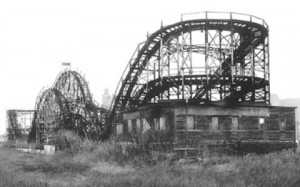 The Circular Railway, is probably the type of roller coaster that most of us rode as children. There are a few hills and slightly fast moments, but for the most part, it goes around in a circle, while going up and down hills. Pretty tame in the eyes of most thrill seekers, but for little kids, it works pretty well, or at least the old style did. I don’t know if some of the current circular railway roller coasters are scary or not.
The Circular Railway, is probably the type of roller coaster that most of us rode as children. There are a few hills and slightly fast moments, but for the most part, it goes around in a circle, while going up and down hills. Pretty tame in the eyes of most thrill seekers, but for little kids, it works pretty well, or at least the old style did. I don’t know if some of the current circular railway roller coasters are scary or not.
Probably one of the most famous roller coasters received it’s patent on this day, January 20, 1885, and was the first Switchback Railway roller coaster. If you thought about it, you might guess that is was at New York’s famous Coney Island. It was designed by LaMarcus Thompson, and debuted in 1884. This roller coaster was considered to be the first successful roller coaster. It was really a fairly primitive Gravity Switchback Railway, but the people loved it, and it immediately began bringing in as much as $600.00 a day…an amazing amount of money in 1884.
Roller coasters continued to be very popular until economic changes in he 1940s, 50s, and 60s caused them to lose their appeal. Nevertheless, the roller coaster would rise again. Now, we have Megacoasters, Hypercoasters, and Gigacoasters. Megacoasters such as Phantom’s Revenge in Pittsburgh’s Kennywood Park or The Beast at King’s Island were first. Hypercoasters standing 200 feet high, the first of which was Cedar Point’s Magnum XL-200 and the Desperado near Las Vegas, Steel Force at Dorney Park in Allentown, Pennsylvania and Mamba at Worlds of Fun  in Kansas City, Missouri, took things to the next level. Cedar Point then introduced Millennium Force, the world’s first Gigacoaster topping off at an astounding 310 feet above the ground.
in Kansas City, Missouri, took things to the next level. Cedar Point then introduced Millennium Force, the world’s first Gigacoaster topping off at an astounding 310 feet above the ground.
I suppose that in order to compete, rollercoasters will continue to become more wild, higher, and scarier as time goes on. I’m sure that many people look forward to each new one that is developed, but since I never liked merry-go-rounds or anything much scarier than a Ferris Wheel, I guess that I will have to leave those riding challenges to someone with more of a stomach for it than I have.
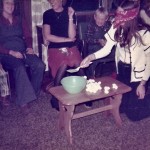 A young friend of mine recently had a new baby, and I was reminded if the age old tradition of the shower. Women through the years have helped brides-to-be and soon to be moms prepare for the upcoming event for some time now. The bridal shower got it’s start in 1890, and is mostly a tradition held in the United States, Canada, Australia, and New Zealand. The baby shower was one that transitioned from the purification rituals that used to occur back when women had to remain in seclusion for 14 days after giving birth, to the naming and baptismal ceremonies, and finally to what they are today, which is more of a way to welcome the new baby with gifts that are necessary for caring for the child. Personally, I like them more for what they are today, as I’m sure most people would agree. These days, the showers just as often include the husband-to-be or the new daddy, in what used to be a pretty much exclusively female party.
A young friend of mine recently had a new baby, and I was reminded if the age old tradition of the shower. Women through the years have helped brides-to-be and soon to be moms prepare for the upcoming event for some time now. The bridal shower got it’s start in 1890, and is mostly a tradition held in the United States, Canada, Australia, and New Zealand. The baby shower was one that transitioned from the purification rituals that used to occur back when women had to remain in seclusion for 14 days after giving birth, to the naming and baptismal ceremonies, and finally to what they are today, which is more of a way to welcome the new baby with gifts that are necessary for caring for the child. Personally, I like them more for what they are today, as I’m sure most people would agree. These days, the showers just as often include the husband-to-be or the new daddy, in what used to be a pretty much exclusively female party.
One tradition, when it comes to showers, that people either like a lot, or completely dislike is the traditional shower 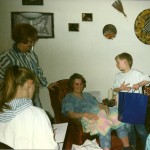 games. We have all been to showers where you tried to name the new baby, diaper a balloon, remember the kitchen utensils on a tray, or give marriage advise to the young couple. Not everyone likes to play these things, and having been to showers of both types, I really have to say that I like both. I think it is simply a matter of taste…and maybe of well thought out games. In the years that I have been attending showers, I have played just about every possible game, and I must say that there have been a few that were great. I personally liked the diapering the balloon, the name game, and the balloon under the shirt game. That one was actually played for the first time…by me anyway, at my niece, Ashley Parmely’s baby shower, and it was hilarious. Of course, as the mother-to-be, Ashley won. The point was to see who could have the biggest belly. Technically, Ashley had a distinct advantage over the rest of us…she had the balloon belly, and the Reagan belly. The rest of us didn’t stand a chance, but it was fun to try to get a belly that was bigger than hers.
games. We have all been to showers where you tried to name the new baby, diaper a balloon, remember the kitchen utensils on a tray, or give marriage advise to the young couple. Not everyone likes to play these things, and having been to showers of both types, I really have to say that I like both. I think it is simply a matter of taste…and maybe of well thought out games. In the years that I have been attending showers, I have played just about every possible game, and I must say that there have been a few that were great. I personally liked the diapering the balloon, the name game, and the balloon under the shirt game. That one was actually played for the first time…by me anyway, at my niece, Ashley Parmely’s baby shower, and it was hilarious. Of course, as the mother-to-be, Ashley won. The point was to see who could have the biggest belly. Technically, Ashley had a distinct advantage over the rest of us…she had the balloon belly, and the Reagan belly. The rest of us didn’t stand a chance, but it was fun to try to get a belly that was bigger than hers.
Some of the funniest shower games are those played with a blindfold on…like the one above, in which my sister-in-law Jennifer Parmely was trying to scoop all the cotton balls into a bowl, without being able to see  them. They are so light that you really don’t know if you have anything on there or not, and since you can’t use your other hand to assist in the process, you find yourself being less than successful. And since it seems that there are always a few little ones in the group, the laughter can get going pretty easily. My brother-in-law, Ron Schulenberg found his sister’s attempts quite hilarious indeed. It’s all intended to break the ice among friends of the honoree, who may not know each other, as well as adding a little bit of laughter and fun to the whole occasion. So the next time you go to a shower, and find that games will be played, try taking a lighter view of it. You might find yourself having a great time, even if you don’t usually like to play those silly shower games.
them. They are so light that you really don’t know if you have anything on there or not, and since you can’t use your other hand to assist in the process, you find yourself being less than successful. And since it seems that there are always a few little ones in the group, the laughter can get going pretty easily. My brother-in-law, Ron Schulenberg found his sister’s attempts quite hilarious indeed. It’s all intended to break the ice among friends of the honoree, who may not know each other, as well as adding a little bit of laughter and fun to the whole occasion. So the next time you go to a shower, and find that games will be played, try taking a lighter view of it. You might find yourself having a great time, even if you don’t usually like to play those silly shower games.
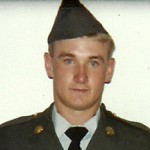 Once a war is over, the people of the world, and especially those who fought in the war never really want to think about it again, but it is, nevertheless, a permanent part of history. It was on this day, January 16, 1991 that America would go to war with Iraq for the first time, and it would be a war that would ultimately draw my brother-in-law, Ron Schulenberg back into the service from the reserves, which is where every soldier is for a time following their active duty term. Ron had joined the Army during a time when things were relatively quiet around the world, and he also ended his active service during a relative time of peace, but all that would change for him when he was notified that he would have to go back to active duty, and to Iraq.
Once a war is over, the people of the world, and especially those who fought in the war never really want to think about it again, but it is, nevertheless, a permanent part of history. It was on this day, January 16, 1991 that America would go to war with Iraq for the first time, and it would be a war that would ultimately draw my brother-in-law, Ron Schulenberg back into the service from the reserves, which is where every soldier is for a time following their active duty term. Ron had joined the Army during a time when things were relatively quiet around the world, and he also ended his active service during a relative time of peace, but all that would change for him when he was notified that he would have to go back to active duty, and to Iraq.
I can only imagine how Ron felt upon receiving that letter. I know how the rest of us felt. We were very concerned for Ron’s safety. None of us wanted him to go, but this was not up to us. The government, and specifically the Army had spoken, and go he would. I remember talking to him about his time over there, years later. One of the things that most civilians wonder about is things like how they felt about killing someone else, or even just seeing a dead body that had been mutilated by the weapons of warfare. For Ron, one of the  strongest memories was marching from one place to another and seeing all the death that was all around them…and then simply stepping over it, like it was a rock or tree stump. In my mind, that would be almost impossible to do, but I suppose that you simply get used to some things…or as much as anyone can get used to war and death.
strongest memories was marching from one place to another and seeing all the death that was all around them…and then simply stepping over it, like it was a rock or tree stump. In my mind, that would be almost impossible to do, but I suppose that you simply get used to some things…or as much as anyone can get used to war and death.
The Persian Gulf War…known as Operation Desert Storm, was a short lived war. Saddam Hussein invaded the little country of Kuwait, because of their oil, making Egypt and Saudi Arabia very nervous, so they called on the United States. When Saddam Hussein refused to leave Kuwait, the war began. The biggest anomaly in Operation Desert Storm, was that the Iraqi soldiers were either not well enough equipped, or simply not willing to die for this cause, and so may of them actually came up to the American troops, and surrendered. I’m sure that the initial fighting, and the amount of war dead lying around the desert, made the decision to surrender seem like the best option. Ron told of this anomaly when we talked about his experiences, and it seemed that it was with a continued sense of relief. I can imagine that the thought of having to kill someone was not one that my brother-in-law relished, but something he would have had to do, had it became necessary.
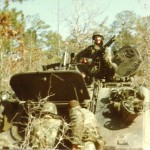
Ron returned to us from Operation Desert Storm, and his time in the reserves ended. The Persian Gulf area would continue to become more and more unstable, but by the time America would again find herself at war with Iraq and Saddam Hussein, Ron was not required to go. While it is my belief that the second war with Iraq has been far more successful, it has also been filed with far more casualties. I believe that if we had gone in and removed Saddam Hussein during Operation Desert Storm, the world would have been a better place. Would that have prevented the need to go back? I don’t know, but it would have spared many of the lives of the countless people that Saddam Hussein slaughtered during his time in power.
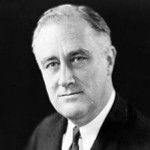
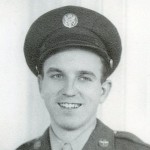 In the height of World War II, on January 14, 1943, President Franklin D Roosevelt made history when he became the first president to travel by airplane on official business. The trip was not without danger. The German U-boats were wreaking havoc on Allied war ships in the Atlantic, and it was decided that a face to face conference was needed to discuss strategy. The man President Roosevelt was going to see, was my fifteenth cousin once removed, Winston Spencer-Churchill. No American President had flown on official business before, but with security in the Atlantic uncertain, Roosevelt’s advisors reluctantly agreed that he should fly. I’m sure his frail health at 60 years of age played a part in their decision too. The secret trip began on January 11, and the plane had to make several stops along the way. They took off from Florida with a first stop in the Caribbean to refuel and allow the president to rest. They then took off and headed south along the South American coast to Brazil, then across the Atlantic to Gambia, finally reaching Casablanca on this day, January 14, 1943.
In the height of World War II, on January 14, 1943, President Franklin D Roosevelt made history when he became the first president to travel by airplane on official business. The trip was not without danger. The German U-boats were wreaking havoc on Allied war ships in the Atlantic, and it was decided that a face to face conference was needed to discuss strategy. The man President Roosevelt was going to see, was my fifteenth cousin once removed, Winston Spencer-Churchill. No American President had flown on official business before, but with security in the Atlantic uncertain, Roosevelt’s advisors reluctantly agreed that he should fly. I’m sure his frail health at 60 years of age played a part in their decision too. The secret trip began on January 11, and the plane had to make several stops along the way. They took off from Florida with a first stop in the Caribbean to refuel and allow the president to rest. They then took off and headed south along the South American coast to Brazil, then across the Atlantic to Gambia, finally reaching Casablanca on this day, January 14, 1943.
It seems strange to us now that they would take such a roundabout route, but things were different then. The Boeing 314 Flying Boat that had been dubbed the Dixie Clipper was a big heavy plane. It had a flight range of 3,500 miles, and the direct route would have been about 4326 miles, making at lease one stop necessary. Since the Secret Service considered air travel for a president as risky anyway, I’m sure they wanted to take a  route that would keep them as far away from any fighting as they could. Also, the final leg of the trip required that the group transfer to an Army transport plane. The C-54 was required to fly at 15,000 feet to cross the Atlas Mountains…an altitude that seems insignificant today, but must have been quite high then. The Secret Service personnel and FDR’s advisors were worried about the oxygen levels affecting the president, and in the end, he did have to go on oxygen for a time during that part of the flight.
route that would keep them as far away from any fighting as they could. Also, the final leg of the trip required that the group transfer to an Army transport plane. The C-54 was required to fly at 15,000 feet to cross the Atlas Mountains…an altitude that seems insignificant today, but must have been quite high then. The Secret Service personnel and FDR’s advisors were worried about the oxygen levels affecting the president, and in the end, he did have to go on oxygen for a time during that part of the flight.
The flight was mastered successfully, and the two men were safely tucked into the Anfa Hotel where Roosevelt and Churchill were both in suites that were close together, making it the perfect place for the conference to take place…after the rooms were cleared of listening devises that had been planted by unknown persons, that is. The advisors and chiefs of staff did most of the hard work of the negotiations, but the presence of Roosevelt and Churchill kept them on task and working toward an agreement. The conference was very important to both sides, as the British were being hit very hard, and Roosevelt needed to keep the American troops advancing and winning their battles, so he could demonstrate to the American people that the tide of this war was turning. People get weary of war quite quickly, and in order to keep their support, victory in battle is key.
The Casablanca Conference was looked at by some as a victory for the British negotiators, because Churchill’s strategy prevailed, but they had missed the fact that the Americans also gained British commitments to long-term goals that went beyond the immediate objectives in the Mediterranean. The Americans agreed to attack Sicily after the victory in North Africa and the British agreed to allow a massive buildup of Allied Forces in  Britain, which would allow for an invasion of France with a target date of May 1, 1944. The invasion actually took place on June 6, 1944, and would become a day we all know as D-Day, when the troops stormed the beaches of Normandy…and that is where my dad came in. Since he was one of the Allied Forces that was stationed in England, his B-17G Bomber was one of those that provided cover for that invasion. It seems quite strange to me that a conference that took place over a year before, and 2 months prior to my dad’s enlistment, would ultimately place him in a position to fight in one of the most well known battles of World War II.
Britain, which would allow for an invasion of France with a target date of May 1, 1944. The invasion actually took place on June 6, 1944, and would become a day we all know as D-Day, when the troops stormed the beaches of Normandy…and that is where my dad came in. Since he was one of the Allied Forces that was stationed in England, his B-17G Bomber was one of those that provided cover for that invasion. It seems quite strange to me that a conference that took place over a year before, and 2 months prior to my dad’s enlistment, would ultimately place him in a position to fight in one of the most well known battles of World War II.
 I don’t know about you, but as a kid in grade school, recess was maybe the best part of the day…if you could get to the swings faster than anyone else. At the school I went to anyway, the swings were the one playground item everyone wanted to be on, and if you were a little slower getting there, you missed out. That usually meant that the younger students had to find something else to do…until they got older anyway. There was no time limit to be on the swings, but most of the kids were pretty good about swinging for a while and then getting off, but then recess was only 15 minutes long, so how much time did that leave the rest of the kids…not much.
I don’t know about you, but as a kid in grade school, recess was maybe the best part of the day…if you could get to the swings faster than anyone else. At the school I went to anyway, the swings were the one playground item everyone wanted to be on, and if you were a little slower getting there, you missed out. That usually meant that the younger students had to find something else to do…until they got older anyway. There was no time limit to be on the swings, but most of the kids were pretty good about swinging for a while and then getting off, but then recess was only 15 minutes long, so how much time did that leave the rest of the kids…not much.
The fight to get to the swings first, and the ultimate lose of that battle for many  children, did very little to sway them from trying to get there, however. Every recess, the bell would ring, and the doors to the playground burst open as the kids ran for the swings. Of course, a few tears were inevitable, because there are always the little fights and little ones don’t always lose well, but all in all, they learned pretty quickly that the best solution to the problem, was to practice your running. The faster you are, the more likely you will end up with a swing.
children, did very little to sway them from trying to get there, however. Every recess, the bell would ring, and the doors to the playground burst open as the kids ran for the swings. Of course, a few tears were inevitable, because there are always the little fights and little ones don’t always lose well, but all in all, they learned pretty quickly that the best solution to the problem, was to practice your running. The faster you are, the more likely you will end up with a swing.
This whole process goes on for a time, and then about 6th grade, which was still in grade school when I was a kid, the kids aren’t so interested in the swings anymore. They have started to mature some and look forward to being more like the kids in junior high, or middle school as it is known today. Playing on the swings was suddenly 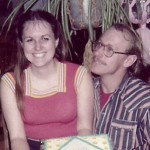 beneath them. How quickly things change. One year, you are fighting over the swings, and the next you are acting like all those little kids are so far beneath you that it is completely unbelievable.
beneath them. How quickly things change. One year, you are fighting over the swings, and the next you are acting like all those little kids are so far beneath you that it is completely unbelievable.
Now flash forward a few years, and…well, I don’t know about you, but it’s funny how much fun those swings can be when you are on a date with your boyfriend. Of course, anything is romantic when you are on a date, right? In the years I dated my husband, Bob, I can’t count how many times we ended up at the park swinging on the swings like little kids. It seemed so different from those grade school days, somehow. It wasn’t nearly as juvenile as it used to be. Now it was romantic…and fun again.
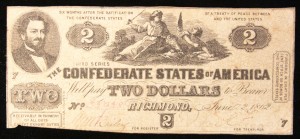 Lately, I have been thinking about the Civil War. I think that most of us have an ancestor or two who fought in the Civil War, possibly from both sides. This was a bloody war that really seems to have been a matter of who could hold out the longest. In the end both sides found themselves scavenging everything from food and water to ammunition from the people who lived in the area. But, the really bad part about the Civil War, was that because the South had succeeded from the Union, and had made their own money, they had a serious problem upon losing the war. After their loss, the South once again became a part of the Union, and their money became worthless.
Lately, I have been thinking about the Civil War. I think that most of us have an ancestor or two who fought in the Civil War, possibly from both sides. This was a bloody war that really seems to have been a matter of who could hold out the longest. In the end both sides found themselves scavenging everything from food and water to ammunition from the people who lived in the area. But, the really bad part about the Civil War, was that because the South had succeeded from the Union, and had made their own money, they had a serious problem upon losing the war. After their loss, the South once again became a part of the Union, and their money became worthless.
These were people who had owned plantations and slaves. They were among the wealthiest people in the 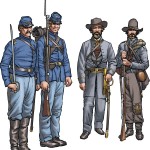 nation. Suddenly they found themselves broke…unless they happened to own gold, and I don’t think many of them did. People had loads of cash, but it wouldn’t buy anything. It might as well have been counterfeit. Not only that, but the entire banking system fell apart. The South found itself in the unique position of not only losing the war, but of losing itself. They were trying to become their own nation, but when they lost the war, they lost their nation. Then, to make matters worse, they lost the money they had too.
nation. Suddenly they found themselves broke…unless they happened to own gold, and I don’t think many of them did. People had loads of cash, but it wouldn’t buy anything. It might as well have been counterfeit. Not only that, but the entire banking system fell apart. The South found itself in the unique position of not only losing the war, but of losing itself. They were trying to become their own nation, but when they lost the war, they lost their nation. Then, to make matters worse, they lost the money they had too.
The whole financial system for them had to be rebuilt. Add to the fact that their side lost the war, the fact that these previously wealthy southern gentlemen and women were now broke, and were forced to work for a living. Their slaves were free, and if they wanted them to work for them, they had to pay them…but with what. The governments war debts were hard enough to deal with, but the individual was in much deeper trouble, because if they had no money, they had no food. There was no money to buy seeds to plant, or cattle to raise… or even ammunition to hunt with, if there was anything left to hunt after your neighbors hunted ahead of you.
or even ammunition to hunt with, if there was anything left to hunt after your neighbors hunted ahead of you.
In the end, I suppose that the only solution was time. Thankfully, the difference between being broke and having money is one paycheck. Debt is something people can learn to live with. There will always be bills to pay, and the family that can keep from borrowing money will do better than the one that must borrow to make ends meet. And the biggest problem they had was that there was no place to borrow from. The people of the south had to learn to work…and that was going to be something very new to most of them.

 In this country, we have been blessed to have people who recognize a national treasure for what it is, and make sure that it gets preserved for people in generations to come to be able to enjoy it too. In my life, I have been blessed to visit many of these treasures, like Yellowstone National Park, Mount Rushmore, Crazy Horse Mountain, Glacier National Park, Niagara Falls, and the Grand Canyon…which was made a national monument on this day, January 11, 1908. Of course, the Grand Canyon was formed thousands of years ago, but it wasn’t until someone looked at it and saw the beauty it could share with so many people, if it was protected from land developers, mining companies, and other such developers who could only see it for its monetary value.
In this country, we have been blessed to have people who recognize a national treasure for what it is, and make sure that it gets preserved for people in generations to come to be able to enjoy it too. In my life, I have been blessed to visit many of these treasures, like Yellowstone National Park, Mount Rushmore, Crazy Horse Mountain, Glacier National Park, Niagara Falls, and the Grand Canyon…which was made a national monument on this day, January 11, 1908. Of course, the Grand Canyon was formed thousands of years ago, but it wasn’t until someone looked at it and saw the beauty it could share with so many people, if it was protected from land developers, mining companies, and other such developers who could only see it for its monetary value.
In my lifetime, I have had the opportunity to visit the Grand Canyon three times. Each time was significantly different from the others. The first time was as a child, and that trip stands out in my mind as the discovery trip. This was a place I had never seen before and probably hadn’t even thought about, but my parents knew of its existence, and that they wanted their girls to be able to see its glorious beauty. I don’t recall feeling wary of it edges, but that was probably because I was the kid, and not the parent who had the task of watching the kids. I just remember that its red walls were gorgeous, especially at sunset. It was a trip taken almost fifty years ago, but I can still remember how amazing it was.
The second trip I took to the Grand Canyon was in 1986, when my husband, Bob Schulenberg and I took our girls, Corrie and Amy to see it. The trip taken as a mother was one that felt a bit different. My girls weren’t so little, and eleven and ten, that they didn’t stay right with us, but nevertheless, Amy found herself just a little too close to the unfenced edge, and she slipped a little. By the grace of God, she didn’t fall in, but it is an event she still talks about to this day. I think she would go back again, because she was not really afraid, once the moment passed, but she gained a respect for edges like that. As the mom, I determined to put myself between the children and the edge from that point on. We still very much enjoyed that trip, but it was very different from either of the others.
The most recent trip Bob and I took to the Grand Canyon was in April of 2009, and it was probably the most fun trip of the three. We didn’t have to worry about little ones, and we were both in good shape. We hiked the 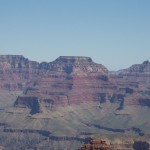
 southern edge of the canyon, and went down into it at both ends of the trail. It was an amazing trip. Looking at the canyon from the top is awesome, but there is something about being down inside it that will always live in my memory files. It wasn’t that the canyon looked so very different when you were inside, but rather that you were inside the Grand Canyon that made that event special. I loved being able to go down the trails and through the tunnel we found there, and see the magnificent beauty up close. It was an amazing trip, and I happily would go again. The Grand Canyon is unforgettable.
southern edge of the canyon, and went down into it at both ends of the trail. It was an amazing trip. Looking at the canyon from the top is awesome, but there is something about being down inside it that will always live in my memory files. It wasn’t that the canyon looked so very different when you were inside, but rather that you were inside the Grand Canyon that made that event special. I loved being able to go down the trails and through the tunnel we found there, and see the magnificent beauty up close. It was an amazing trip, and I happily would go again. The Grand Canyon is unforgettable.
 I was looking at some of my uncle, Bill Spencer’s family history information yesterday, and I came across a comment he made about some of the pictures. It was about the National Youth Administration that was transferred to the War Manpower Commission in 1941. When he mentioned that it was about educating the nation’s youth, I immediately got on the defensive, because I thought that it almost sounded like the Nazis pulling children out of their homes to train them the way the government wanted them to be trained. Of course, that couldn’t be further from the truth. In reality, and had I read the rest of Uncle Bill’s comments before I got touchy about it, I would have known that. I think sometimes, we have a preconceived idea about things, and we don’t really understand exactly what is going on before we fly off the handle.
I was looking at some of my uncle, Bill Spencer’s family history information yesterday, and I came across a comment he made about some of the pictures. It was about the National Youth Administration that was transferred to the War Manpower Commission in 1941. When he mentioned that it was about educating the nation’s youth, I immediately got on the defensive, because I thought that it almost sounded like the Nazis pulling children out of their homes to train them the way the government wanted them to be trained. Of course, that couldn’t be further from the truth. In reality, and had I read the rest of Uncle Bill’s comments before I got touchy about it, I would have known that. I think sometimes, we have a preconceived idea about things, and we don’t really understand exactly what is going on before we fly off the handle.
The education effort that my uncle was talking about was set up by the National Youth Administration through the War Manpower Commission, and had to do with the upcoming and inevitable entrance of the United States into World War II. The skills that were going to be needed to build the equipment needed for our troops to fight in the war were very different from the skills the nation’s youth had at that time, because many of them were farmers. The nation was going to need welders, machinists, and sheet metal workers desperately. The training program was designed to provide training for youth 16 to 25 years of age. The plan was that the ones who were not drafted could help with the war effort at home.
It was this program that trained my dad, Uncle Bill, Aunt Laura, and Aunt Ruth to weld, and gave them jobs in the shipyards in several different capacities, mostly as Rosie the Riveters. Of course, while Uncle Bill did a similar job to the ones done by his sisters, I don’t think he would take too kindly to the name Rosie the Riveter. Nevertheless, it was on May 1, 1942 that Uncle Bill began his training, and shortly there after, he talked my dad into doing the training too. Uncle Bill had hoped that welding would keep them both on the home front, but when that was not to be, they both went to sign up. Dad was accepted, but Uncle Bill was not, because of flat feet and a hernia. Still, the welding skill was not something that would ever be a waste where my dad was concerned, because he worked as a welder for most of his life after the war was over.
The National Youth Administration officially operated from June 26, 1935 to 1939, and was designed to provide training and help find jobs for people during the Great Depression. It was part of The New Deal programs set up by President Franklin D Roosevelt during his first term in office. I don’t often agree with government run programs, I suppose this one had it’s place. Many of the people who benefitted from the chance to train themselves for a new skill were farmers who didn’t have many other skills, and it was the training my dad received there that supported our family for his entire working life. The National Youth Administration was officially transferred to the War Manpower Commission in 1942, and officially folded in 1943. It was most likely due to lack of funding to continue the program, but I suppose it served a greater purpose during the war years, and now was no longer necessary.
 For the past several weeks, I have been exchanging emails and lots of information with a man named John B Knox. He is my husband, Bob Schulenberg’s sixth cousin once removed. I came across his website about a year or so ago, but it wasn’t until recently that I decided to contact him. This was such a great decision on my part, because it has been an interesting journey. Because John had the last name of Knox, and some of the same relatives that I knew to be in the Knox line of my mother-in-law’s family, I had no doubt in my mind that we are related, but I didn’t know the exact relationship. Finding someone who is a descendant of an aunt or uncle back in the 1800s and especially beyond that, isn’t as easy as one might think. It is very helpful when you find someone who has researched their family history as well as John has, because the research is more that half done. It was easy for John to connect our two lines and tell me exactly what the connection was. John is a very thorough person too, so he was able to send me an easy to follow diagram of the connection. Now, my family tree shows the connection to John and his family in detail.
For the past several weeks, I have been exchanging emails and lots of information with a man named John B Knox. He is my husband, Bob Schulenberg’s sixth cousin once removed. I came across his website about a year or so ago, but it wasn’t until recently that I decided to contact him. This was such a great decision on my part, because it has been an interesting journey. Because John had the last name of Knox, and some of the same relatives that I knew to be in the Knox line of my mother-in-law’s family, I had no doubt in my mind that we are related, but I didn’t know the exact relationship. Finding someone who is a descendant of an aunt or uncle back in the 1800s and especially beyond that, isn’t as easy as one might think. It is very helpful when you find someone who has researched their family history as well as John has, because the research is more that half done. It was easy for John to connect our two lines and tell me exactly what the connection was. John is a very thorough person too, so he was able to send me an easy to follow diagram of the connection. Now, my family tree shows the connection to John and his family in detail.
Getting to know John has been a lot of fun. He was born in Kentucky, but he and his family now live in Washington DC. I could try to summarize his career, but I think he says it best so I will quote it instead. According to John’s LinkedIn page, “I currently serve as a Congressional Liaison for the Defense Intelligence Agency (DIA). My background includes two decades+ of experience in management, strategic planning, change management, international business development, customer relations and team building. Highlights include my seven years as NASA’s Manager of Video Applications. The 35-member team that I led, using the world class production facilities that my team designed and built, won 44 awards on behalf of the space agency, including four Emmy’s. That record at NASA remains unmatched. I co-chaired the agency-wide Standards Committee for High Definition Television at NASA which established technical guidelines for the space agency’s transition to HDTV. Today, the guidelines which my group developed, continues to insure the interoperability of communications between each of NASA’s ten world-class research centers and the International Space Station. While serving as the DIA’s Contracting Office Manager in Baghdad, Iraq, I oversaw a “ground-up” conversion of twelve Iraqi buildings for use as DIA’s in-country Headquarters, Annex and billeting for deployed U.S. personnel. For this project, I was awarded DIA’s Civilian Combat Support Award. Most recently, I drafted, proposed and am currently leading the implementation the first Congressional Communications Strategic Plan for DIA. I hold a Bachelor’s Degree in Communications Technology, a Master’s Degree in Media Management (Magna Cum Laude graduate) and a Master Of Business Administration (MBA) Degree with a concentration in management.” All I could say to that was…”Wow!!”
This, of course, lets me know that I really knew nothing of the person, that I had so boldly contacted, and who so graciously contacted me back, and has helped me immensely with my inquiries. I have always known that the Knox family has been heavily into politics, and other areas of government work, and this Knox family member has obviously followed in the footsteps of his ancestors. I can’t say that I’m disappointed in that. I also know that his work at NASA interests me as well. I’m sure he would not have brought all this up to me on his own, because he never made the conversations we had about himself, but rather about the family history, and our connection to it. I think he is probably a humble man, and only put the information I gave here on LinkedIn, because that is what he was supposed to do on LinkedIn. Nevertheless, I must say that I am impressed with all he has done, and excited to know him and to get to know his family as wall. John and his wife Lisa have two daughters, Lindsey and Kelly. I am excited about this new branch of my family history, and I look forward to getting to know this family even better.

